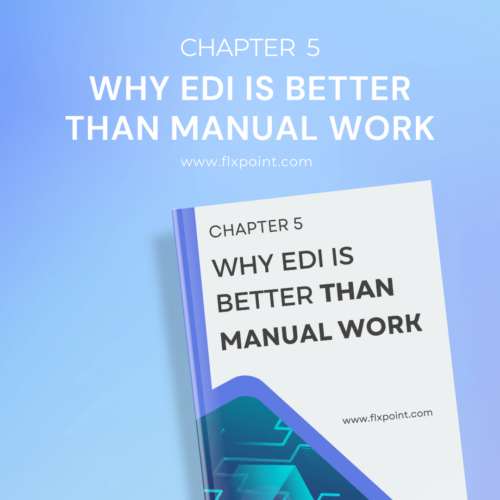Chapter 2 How EDI Helps Ecommerce Businesses
Explore how EDI enhances your ecommerce operations. From improving efficiency to cutting costs, see how EDI can make your business more competitive.

Chapter 2: How EDI Helps Ecommerce Businesses
Electronic Data Interchange (EDI) is revolutionizing ecommerce by streamlining operations and enhancing communication between businesses and suppliers. It replaces manual processes with automated data exchanges, making transactions faster and more accurate. Automation reduces the time spent on repetitive tasks and minimizes human errors, leading to better efficiency and increased customer satisfaction.
For ecommerce businesses, EDI is essential for managing complex operations like order processing, inventory updates, and shipping notifications. It allows businesses to scale effortlessly while maintaining accuracy and speed. By adopting EDI, companies can build stronger relationships with suppliers and deliver a seamless shopping experience to their customers.
Saves Time by Automating Tasks
EDI (Electronic Data Interchange) revolutionizes how ecommerce businesses operate by automating repetitive tasks that would otherwise consume significant time and resources. Through automation, EDI helps streamline operations, reduce manual errors, and improve overall efficiency. Here’s how:
Elimination of Repetitive Manual Tasks.
- Automated Order Processing – EDI automatically transfers order details from customers to suppliers, eliminating the need for manual entry.
- Real-Time Inventory Updates – Inventory levels are synced in real time, ensuring accurate stock availability without manual adjustments.
- Invoice Generation and Payment Processing – Automated creation and delivery of invoices reduce back-and-forth communications.
- Shipping Notifications – EDI enables automatic updates on order status and tracking, keeping customers informed without extra effort.
Examples of Time-Saving Scenarios in Ecommerce Operations.
- Multi-Channel Sales Integration – Orders from multiple sales channels (e.g., website, marketplaces) are consolidated and processed through EDI, avoiding the need to manage each channel separately.
- Supplier Coordination – Purchase orders, inventory requests, and shipment schedules are automatically shared with suppliers, reducing email and phone communication.
- Returns Management – EDI automates return authorizations and inventory adjustments, saving time for both customers and staff.
How Automation Benefits Both Ecommerce Stores and Suppliers.
For Ecommerce Stores:
- Faster order fulfillment improves customer satisfaction.
- Staff can focus on strategic tasks instead of repetitive data entry.
- Reduced operational bottlenecks during peak sales periods.
For Suppliers:
- Streamlined communication leads to fewer errors and delays.
- Inventory management becomes more efficient with real-time updates.
- Faster order processing improves cash flow and supplier satisfaction.
Reduces Mistakes Caused by Manual Data Entry
Manual data entry often leads to mistakes that can disrupt business operations and damage customer relationships. EDI (Electronic Data Interchange) eliminates these issues by automating the transfer of information between businesses. Here’s how it addresses the problem of data accuracy in ecommerce:
Common Errors in Manual Processes and Their Impact on Business
- Typographical Errors – Manually entering orders, prices, or shipping details can result in typos, causing incorrect shipments or pricing discrepancies. These errors frustrate customers and waste resources.
- Duplicate Data Entries – Employees may accidentally input the same data multiple times, leading to duplicate shipments or overbilling. This negatively impacts inventory and finances.
- Data Omission – Skipping important details, like product specifications or shipping addresses, creates delays or incomplete orders, harming customer satisfaction.
- Time-Intensive Corrections – Identifying and fixing manual errors consumes time and increases labor costs, delaying key processes like order fulfillment.
- Poor Customer Experience – Mistakes in orders or invoices reduce trust and loyalty, pushing customers to competitors.
Role of EDI in Improving Data Accuracy Across Transactions
- Automation Eliminates Human Error – EDI automates processes like order placement, invoicing, and inventory updates, ensuring accuracy in every transaction. No manual input reduces the risk of errors.
- Standardized Data Formats – EDI uses standardized formats that all parties agree on. This ensures consistent data transfer without interpretation errors.
- Real-Time Data Validation – EDI systems validate data in real-time, flagging discrepancies or incomplete fields before processing transactions. This prevents errors from propagating through the system.
- Seamless Integration with Systems – EDI integrates with ecommerce platforms, suppliers, and payment processors, syncing data accurately across all channels. This eliminates the need for manual cross-checks.
- Error Tracking and Reporting – Advanced EDI solutions provide detailed logs and reports, helping businesses identify patterns of errors and improve processes over time.
Speeds Up Order Processing and Deliveries
EDI (Electronic Data Interchange) plays a key role in accelerating order processing and improving delivery timelines. Streamlining communication and automating data exchange, enables ecommerce businesses to meet customer expectations efficiently. Here’s how EDI makes a difference:
Faster Communication with Suppliers and Fulfillment Partners
- Real-time Updates – EDI enables instant exchange of purchase orders, invoices, and shipping details between businesses and suppliers.
- Eliminates Delays – Manual communication methods like emails or faxes are time-consuming. EDI ensures that critical information is delivered promptly.
- Improved Collaboration – Seamless communication builds trust and enhances relationships with suppliers and fulfillment partners.
How EDI Reduces Delays in Order Confirmations and Shipping Updates
- Automated Order Confirmations – EDI immediately confirms orders, eliminating the lag associated with manual processing.
- Streamlined Shipping Notifications – Automated notifications keep all parties updated on order status and delivery schedules.
- Fewer Errors – By automating data entry, EDI reduces the likelihood of errors that cause processing or shipping delays.
The Impact of Quicker Deliveries on Customer Loyalty and Retention
- Enhanced Customer Satisfaction – Timely deliveries exceed customer expectations, leading to positive reviews and repeat purchases.
- Increased Trust – Accurate and fast fulfillment builds credibility and strengthens customer trust in your brand.
- Competitive Advantage – Offering quick deliveries sets your ecommerce business apart in a competitive market, fostering long-term customer loyalty.
Keeps Your Customers and Suppliers Happy
In ecommerce, building strong relationships with both suppliers and customers is crucial. EDI (Electronic Data Interchange) plays a key role in enhancing these relationships by ensuring seamless communication, accurate order fulfillment, and timely deliveries.
Strengthening Supplier Relationships Through Seamless Communication
- EDI enables a quick and accurate exchange of information, reducing the chances of errors.
- Suppliers receive orders instantly, allowing them to fulfill requests without delays.
- Real-time data exchange helps maintain accurate inventory levels, ensuring that stockouts and overstocking are avoided.
- Consistent, clear communication builds trust, ensuring that suppliers are more willing to offer better terms and discounts.
Meeting Customer Expectations for Accurate Orders and Timely Deliveries
- EDI helps reduce manual errors in order processing, ensuring that customers receive the correct products.
- Automated order confirmations and tracking details are sent instantly, improving customer satisfaction.
- Quick and accurate information flow leads to faster order fulfillment and delivery, meeting customer expectations for timely service.
- EDI eliminates delays caused by miscommunication or data entry mistakes, ensuring a smooth customer experience from start to finish.
How EDI Fosters Trust and Repeat Business in Ecommerce
- EDI’s accuracy and speed create a reliable and predictable process for both customers and suppliers.
- By consistently meeting customer expectations for accuracy and delivery time, businesses build trust.
- When suppliers can efficiently fulfill orders without delays, they are more likely to become long-term partners.
- A smooth experience, powered by EDI, leads to customer loyalty, repeat purchases, and positive word-of-mouth, which are essential for business growth.
EDI and Dropshipping
EDI (Electronic Data Interchange) is especially valuable for dropshipping businesses, as it automates many of the manual tasks associated with product ordering, inventory management, and supplier communication. Below are the key ways EDI benefits dropshipping operations:
Specific Benefits of EDI for Dropshipping Businesses
- Faster Order Processing – EDI allows for automatic order transmission between businesses and suppliers, reducing delays and improving response times.
- Accuracy – By removing human errors in manual data entry, EDI ensures that order details, inventory levels, and shipment information are accurate.
- Cost Savings – Automation cuts down on administrative labor costs and reduces the need for paper-based documentation.
- Streamlined Communication – EDI enables quick communication with suppliers, helping to solve issues or clarify details in real time.
Real-Time Inventory Syncing and Automated Order Management
- Real-Time Updates – With EDI, inventory levels are updated automatically as orders are placed, ensuring accurate stock availability in real-time.
- Automated Order Fulfillment – Orders are automatically transmitted to suppliers, and confirmation details (such as shipping updates) are sent back instantly. This reduces the need for manual tracking.
- Elimination of Stockouts and Overselling – By syncing inventory levels in real-time, businesses avoid selling products that are out of stock or accidentally overselling.
Importance of EDI for Managing Multi-Supplier Relationships
- Simplified Communication – EDI creates a consistent and efficient way to manage orders with multiple suppliers, ensuring clear communication for all transactions.
- Order Coordination – Dropshipping often involves working with various suppliers for different products. EDI allows businesses to coordinate orders from different sources easily.
- Reduced Errors – EDI reduces the risk of errors when managing multiple suppliers, making the process more streamlined and reliable.
EDI and Ecommerce Growth
As ecommerce businesses grow, they face challenges like increased order volumes, complex supply chain management, and the need for faster, more accurate transactions. EDI (Electronic Data Interchange) plays a crucial role in supporting the growth of ecommerce by automating and streamlining these processes.
How EDI Supports Scaling Ecommerce Operations
- EDI automates data exchange between ecommerce platforms, suppliers, and customers, reducing manual work and errors.
- As the business scales, EDI can manage larger volumes of transactions without overwhelming the system.
- By integrating EDI, businesses can handle multiple suppliers and customer orders simultaneously, improving operational efficiency.
Enabling Businesses to Handle Increasing Order Volumes Efficiently
- With the rise in order volumes, EDI ensures quick, accurate processing of orders, which speeds up the fulfillment process.
- Real-time inventory updates through EDI prevent stockouts and over-ordering, ensuring smooth order flow.
- Automated order management reduces the time spent on administrative tasks, freeing up resources to focus on growth.
Future-proofing Ecommerce with Advanced EDI Integrations
- Advanced EDI integrations allow businesses to adopt new technologies, like artificial intelligence (AI) and machine learning, to predict trends and optimize inventory.
- EDI solutions can be easily updated and customized to accommodate future business needs, helping businesses stay competitive.
- By integrating EDI with other systems like CRM and ERP, businesses can ensure seamless, end-to-end operations that can adapt to market changes.
Conclusion
EDI plays a crucial role in enhancing ecommerce efficiency by automating processes, reducing manual errors, and speeding up order fulfillment. By simplifying operations, EDI helps businesses lower costs, streamline communication, and improve overall productivity. These benefits lead to higher customer satisfaction and stronger supplier relationships. Ecommerce businesses, including dropshipping models, can scale more effectively with EDI solutions tailored to their needs. Adopting EDI technology is essential for businesses looking to stay competitive, optimize workflows, and meet the growing demands of the digital marketplace.
Guide Chapters
- Chapter 1: What is EDI?
- Chapter 2: How EDI Helps Ecommerce Businesses
- Chapter 3: Everyday Uses of EDI in Ecommerce
- Chapter 4: How to Start Using EDI
- Chapter 5: Why EDI is Better Than Manual Work
- Chapter 6: EDI vs. APIs: What's the Difference?
- Chapter 7: The Future of EDI in Ecommerce
- Chapter 8: Your First Steps with EDI
- Chapter 9: EDI is the Future of Ecommerce
- Chapter 10: Quick Glossary of EDI terms
- Chapter 11: Checklist to Prepare for EDI Setup
All Chapters in This Guide

Start with the essentials. This chapter breaks down what EDI is, how it works, and why it’s a critical tool for modern ecommerce businesses. We simplify the technical jargon so you can clearly understand how EDI automates the exchange of business documents with your suppliers, warehouses, and trading partners.

Explore the powerful benefits EDI brings to your ecommerce operations. From faster communication and fewer errors to cost savings and improved accuracy, this chapter shows how EDI makes your business leaner, smarter, and more competitive.

See how EDI shows up in real day-to-day workflows. This chapter highlights common applications like order placement, shipping confirmations, inventory updates, and invoicing—so you can understand the practical ways EDI supports smooth operations.

Ready to get started? This chapter walks you through the process of adopting EDI, including evaluating your current tech stack, selecting the right partners, and integrating EDI into your existing systems. No technical background required—we make it approachable.

If you're still relying on spreadsheets, emails, or manual uploads to exchange data, this chapter is a game-changer. Learn how EDI eliminates human error, speeds up workflows, and allows your business to scale without adding more headcount.

Wondering when to use EDI or APIs? We break down the differences between these two powerful tools, when each makes the most sense, and how they can work together in a well-rounded ecommerce tech stack.

EDI is evolving rapidly. In this chapter, we explore upcoming innovations—like machine learning, tighter integrations with fulfillment partners, and greater automation. Discover how to stay ahead of the curve and be ready for what’s next.

It’s time to take action. This chapter provides a hands-on guide to assessing your business readiness, aligning with trading partners, and identifying the tools you need to implement EDI smoothly and successfully.

This isn’t just a short-term solution—it’s a long-term strategy. Learn why businesses adopting EDI today are better positioned to grow, adapt to change, and lead in a digitally connected ecommerce world.

EDI doesn’t have to be intimidating. We’ve created a glossary of key terms and acronyms to make the language of EDI more accessible, so you can communicate confidently with partners and providers.

Make sure you’re truly ready. This checklist walks through everything you’ll need to set up EDI the right way—from choosing the right platform to aligning your workflows and evaluating technical requirements. Consider this your pre-launch playbook.
Kenneth Cole's Smart Savings With Shopify EDI Connections
"They had never used Flxpoint before. But working with [the Flxpoint] team, they learned it and we're about to onboard our newest footwear partner, and you know that's big business for us.”
Mitul PatelKenneth Cole


How Flxpoint Helped Rifle Supply Automate & Grow
“I went line by line… whatever the inventory number was and cost value was, I calculated it and was blown away by how much that was worth— $300 million worth of product that I added to our web store.”
Chris MekdaraRifle Supply


The Ecommerce Automation Behind Screen Skinz
"Automation is the key to maximizing your volume. [Flxpoint] comes right into our flow — everything's automated. We want it to be quick and efficient. So that's what we love about Flxpoint."
Shaun Brown & Clay CanningScreenSkinz


How Inhaven Transformed Vendor Management with Flxpoint
"We ended up switching to Flxpoint, and it has been a much smoother process. Where it took us six months to get onboarded with the other company, we were up and running in a week or two with Flxpoint."
Ashley ChingInhaven


How Black Patch Performance Scaled Smarter with Flxpoint
"The only way to actually scale was to go through Flxpoint… You can’t even come close to hiring someone to do what Flxpoint does for the price."
Jonathan WilliamsBlack Patch Performance


